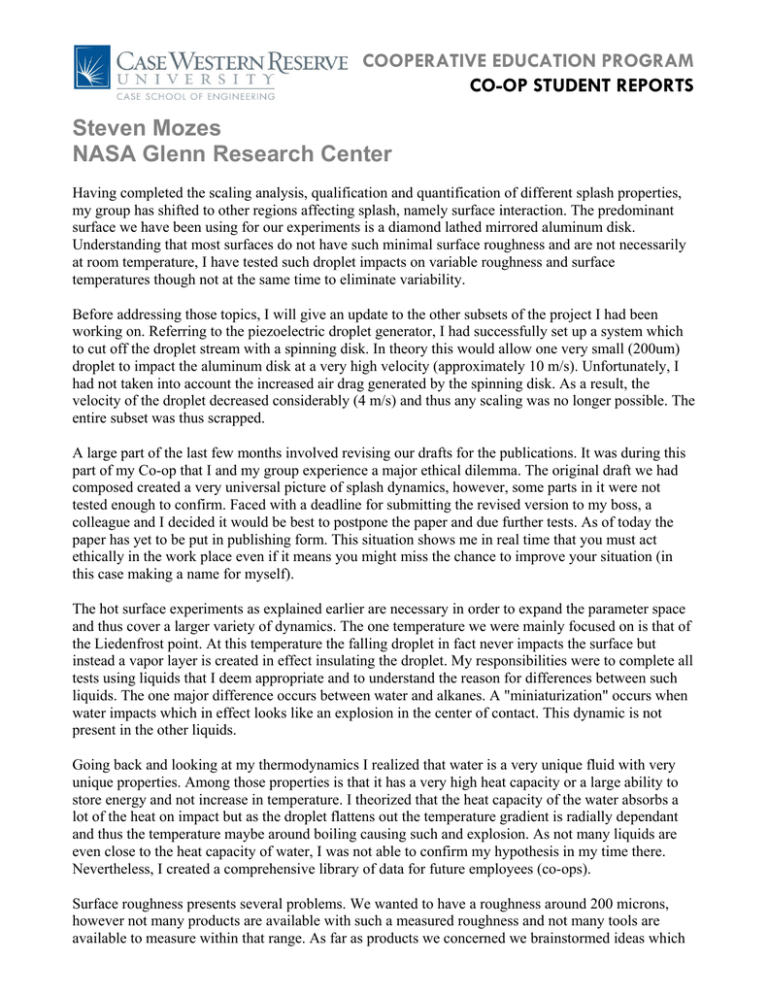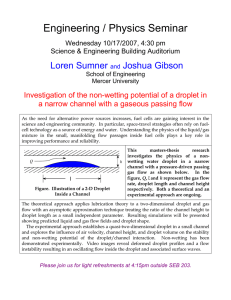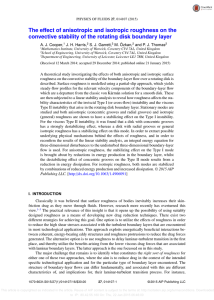Steven Mozes NASA Glenn Research Center COOPERATIVE EDUCATION PROGRAM CO-OP STUDENT REPORTS
advertisement

COOPERATIVE EDUCATION PROGRAM CO-OP STUDENT REPORTS Steven Mozes NASA Glenn Research Center Having completed the scaling analysis, qualification and quantification of different splash properties, my group has shifted to other regions affecting splash, namely surface interaction. The predominant surface we have been using for our experiments is a diamond lathed mirrored aluminum disk. Understanding that most surfaces do not have such minimal surface roughness and are not necessarily at room temperature, I have tested such droplet impacts on variable roughness and surface temperatures though not at the same time to eliminate variability. Before addressing those topics, I will give an update to the other subsets of the project I had been working on. Referring to the piezoelectric droplet generator, I had successfully set up a system which to cut off the droplet stream with a spinning disk. In theory this would allow one very small (200um) droplet to impact the aluminum disk at a very high velocity (approximately 10 m/s). Unfortunately, I had not taken into account the increased air drag generated by the spinning disk. As a result, the velocity of the droplet decreased considerably (4 m/s) and thus any scaling was no longer possible. The entire subset was thus scrapped. A large part of the last few months involved revising our drafts for the publications. It was during this part of my Co-op that I and my group experience a major ethical dilemma. The original draft we had composed created a very universal picture of splash dynamics, however, some parts in it were not tested enough to confirm. Faced with a deadline for submitting the revised version to my boss, a colleague and I decided it would be best to postpone the paper and due further tests. As of today the paper has yet to be put in publishing form. This situation shows me in real time that you must act ethically in the work place even if it means you might miss the chance to improve your situation (in this case making a name for myself). The hot surface experiments as explained earlier are necessary in order to expand the parameter space and thus cover a larger variety of dynamics. The one temperature we were mainly focused on is that of the Liedenfrost point. At this temperature the falling droplet in fact never impacts the surface but instead a vapor layer is created in effect insulating the droplet. My responsibilities were to complete all tests using liquids that I deem appropriate and to understand the reason for differences between such liquids. The one major difference occurs between water and alkanes. A "miniaturization" occurs when water impacts which in effect looks like an explosion in the center of contact. This dynamic is not present in the other liquids. Going back and looking at my thermodynamics I realized that water is a very unique fluid with very unique properties. Among those properties is that it has a very high heat capacity or a large ability to store energy and not increase in temperature. I theorized that the heat capacity of the water absorbs a lot of the heat on impact but as the droplet flattens out the temperature gradient is radially dependant and thus the temperature maybe around boiling causing such and explosion. As not many liquids are even close to the heat capacity of water, I was not able to confirm my hypothesis in my time there. Nevertheless, I created a comprehensive library of data for future employees (co-ops). Surface roughness presents several problems. We wanted to have a roughness around 200 microns, however not many products are available with such a measured roughness and not many tools are available to measure within that range. As far as products we concerned we brainstormed ideas which resulted in three types of surfaces. They were a simple cross cut file, aluminum disk scratched with sand paper, and quartz frits with varying porosities. One of my jobs was to find a way to measure surface roughness. A profilometer was an obvious choice but the only one available to us was one which could measure roughness in a range smaller than ours. We also tried using one of the world's finest scanning electron microscopes however the piece was to large to maneuver. The only other instrument I found that might do the job was a perthometer an instrument in which I am not at all familiar with. I contacted the person to which this instrument belonged and he had no problem with me using it. The caveat (of course there has to be one) was that he had no real idea how to work it and it was out of calibration. Being that the instrument was my only hope, I ventured over to the building and attempted to learn how to operate it. Although I spent all day with the machine, I figured it out and ended up not only measuring my surfaces but also many others from people in the building. As with the hot surfaces I also created a large library of data and hypothesized on the dynamics. The last day of my Co-op was a sad one (I almost cried). I made some very close friends there and some very important contacts. My reason for participating in this program involved getting experience and making contacts. I can say without a doubt I have achieved those goals. I learned the importance of communication, experimentation, and the thinking and integration of class work that must go along with projects. This program should be commended on what it offers for it gives so much. I am honored to be apart not only of Nasa Glenn, but with the Co-op program in general. Thank you so much.





